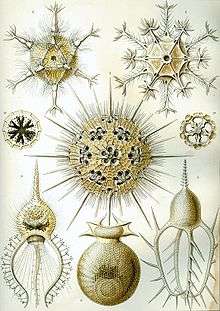Phaeodarea
The Phaeodarea are a group of amoeboid Cercozoa. They are traditionally considered radiolarians,[1] but in molecular trees do not appear to be close relatives of the other groups, and are instead placed among the Cercozoa.[2] They are distinguished by the structure of their central capsule and by the presence of a phaeodium, an aggregate of waste particles within the cell.
| Phaeodarea | |
|---|---|
 | |
| "Phaeodaria" from Ernst Haeckel's Kunstformen der Natur, 1904 | |
| Scientific classification | |
| Domain: | Eukaryota |
| (unranked): | SAR |
| (unranked): | |
| Phylum: | |
| Class: | Phaeodarea Haeckel, 1879 |
| Orders | |
| |
| Synonyms | |
|
Phaeodaria Haeckel, 1879 | |
The term "Radiozoa" has been used to refer to radiolaria when Phaeodarea is explicitly excluded.[3]
Phaeodarea produce hollow skeletons composed of amorphous silica and organic material, which rarely fossilize. The endoplasm is divided by a cape with three openings, of which one gives rise to feeding pseudopods, and the others let through bundles of microtubules that support the axopods. Unlike true radiolarians, there are no cross-bridges between them. They also lack symbiotic algae, generally living below the photic zone, and do not produce any strontium sulphate.
References
- Polet S, Berney C, Fahrni J, Pawlowski J (March 2004). "Small-subunit ribosomal RNA gene sequences of Phaeodarea challenge the monophyly of Haeckel's Radiolaria". Protist. 155 (1): 53–63. doi:10.1078/1434461000164. PMID 15144058.
- Nikolaev, Sergey I.; Cédric Berney; José F. Fahrni; Ignacio Bolivar; Stephane Polet; Alexander P. Mylnikov; Vladimir V. Aleshin; Nikolai B. Petrov; Jan Pawlowski (2004). "The twilight of Heliozoa and rise of Rhizaria, an emerging supergroup of amoeboid eukaryotes". Proceedings of the National Academy of Sciences. 101 (21): 8066–8071. doi:10.1073/pnas.0308602101. ISSN 0027-8424. PMC 419558. PMID 15148395.
- Moreira D, von der Heyden S, Bass D, López-García P, Chao E, Cavalier-Smith T (July 2007). "Global eukaryote phylogeny: Combined small- and large-subunit ribosomal DNA trees support monophyly of Rhizaria, Retaria and Excavata". Mol. Phylogenet. Evol. 44 (1): 255–66. doi:10.1016/j.ympev.2006.11.001. PMID 17174576.
| Wikispecies has information related to Phaeodarea |